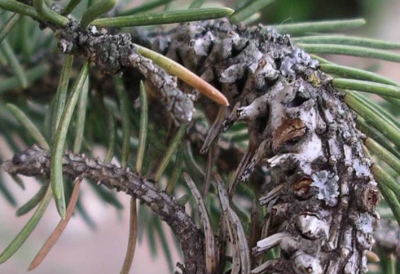Tree Care For Blue Spruce Diseases –
Cooley Spruce Gall
Cooley spruce galls are structures developing on new growth of spruce trees as a result of an insect infestation. Cooley spruce gall adelgids, also known in tree care industry as woolly aphids, use spruce galls for reproduction. Tree spraying for blue spruce diseases can prevent heavy infestations that can cause growth retardation and distortion in spruce trees. In most cases, spruce galls do not cause long-term serious harm to the tree itself. However, galls can interfere with the natural formation of the tree branches. Galls can curl and stunt twig growth, eventually killing new growth all together. Often in subsequent years, healthy new growth can return. Home and property owners generally employ Cooley spruce gall control for aesthetic reasons.
Galls generally appear on spruce trees during late spring and early summer when new growth is developing. Female woolly aphids lay hundreds of eggs near buds. Nymph aphids hatch and feed on new growth. It is this feeding action that produces a chemical response in the trees that results in gall production. They often go unnoticed until mid-July when they dry out and start to brown. At first glance, they can be falsely identified as seed cones.
Woolly aphids can also lay eggs on Douglas fir trees. In fact, the aphids need both species of tree to complete their life cycle. Douglas fir do not produce galls, but the trees become very unsightly. The needles turn yellow and appear bent. The tree will have an overall speckled look with small cottony balls, a form of the aphid, on the branches.
Signs of Attack

- Galls on new growth: These are small growths covering the tip of new growth
- Curling: Cooley spruce galls often curve to one side instead of the outward appearance of uninfected branch tips.
- Stunting: Spruce galls generally grow from 1-3 inches long. As unaffected branch tips grow, galls will appear much shorter.
- Yellow or crooked needles on Douglas fir: If you have Douglas fir on or near your property, look for signs of woolly aphid feeding. There is generally little disfiguration to the tree with some partial needle fall.
Tree Care to Control and Prevent Cooley Spruce Gall
To maintain tree health, Cooley Spruce Gall control is rarely needed. If you are like most property owners, you want to maintain the natural beauty of your trees and you may want to prevent an attack from woolly aphids. SprayTech is spraying for spruce disease in the Denver, Castle Rock and Larkspur area and are experts on maintaining healthy, beautiful trees.
Spraying for Cooley spruce gall must be done before galls develop. If you have spruce and Douglas fir trees living in vicinity of your property, you may be at risk for galls. Foliar treatments and horticultural oils are applied in either the fall or, more commonly, in the spring. Our licensed and experienced technicians at SprayTech know the correct time to treat for Cooley spruce gall. In Colorado, this is often done in late-April, just before the insects have begun to develop eggs.
If you want to have an expert determine your risk or help develop a treatment plan for Cooley spruce galls on your property, contact a SprayTech expert today.

